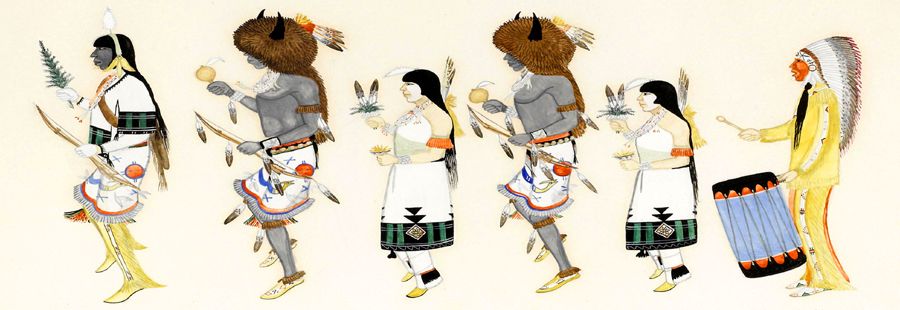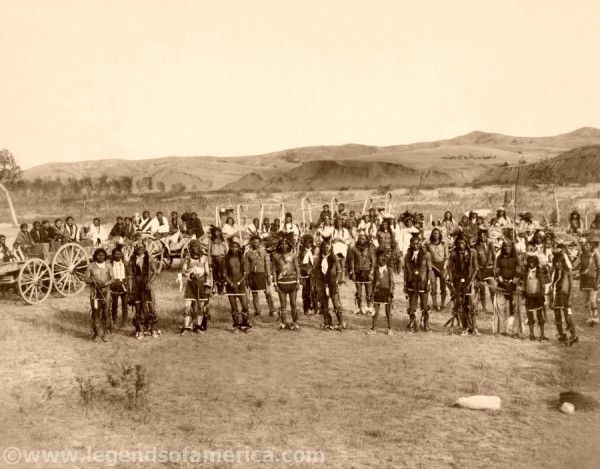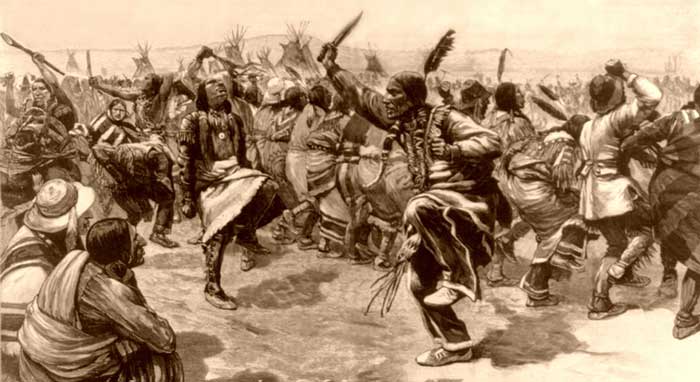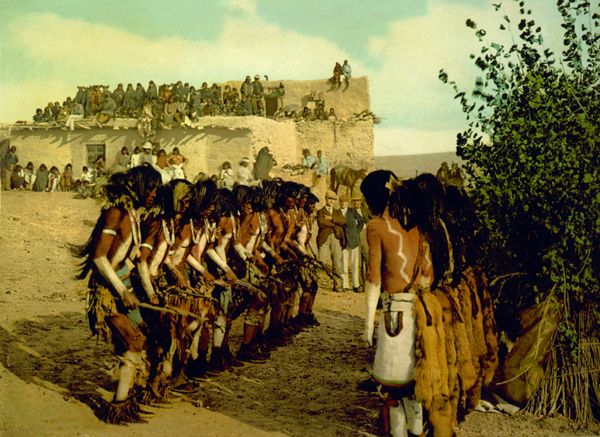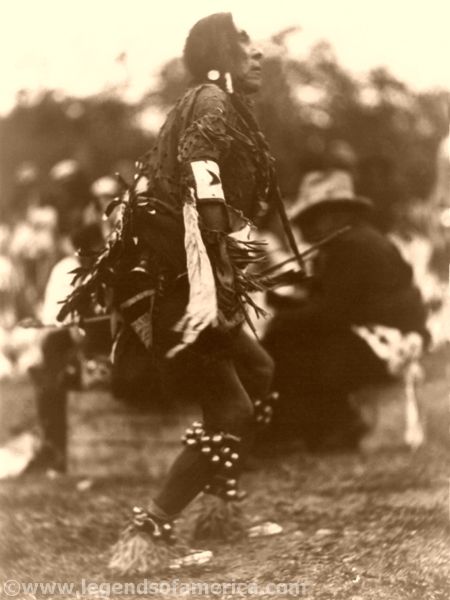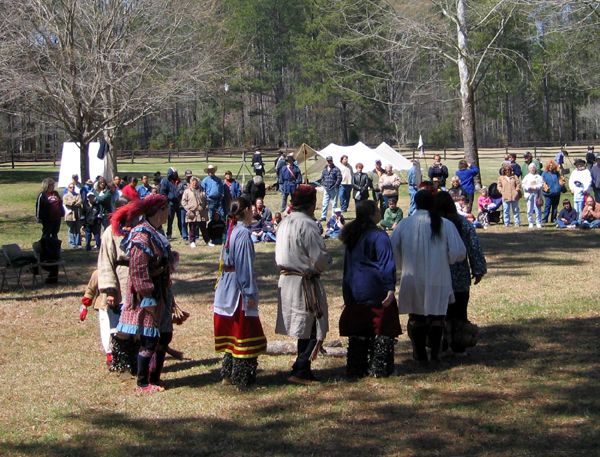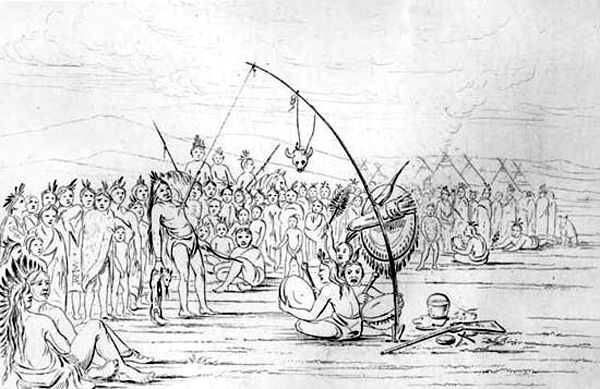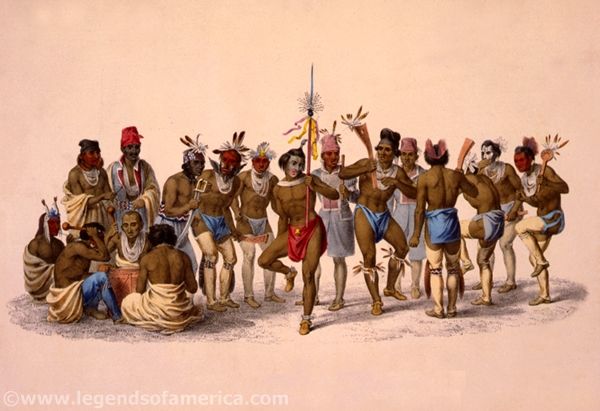Native American Dances – Legends of America (original) (raw)
Buffalo Dance Group by Awa Tsireh.
Dances have always been significant in the lives of Native Americans as both a common amusement and a solemn duty. Many dances played a vital role in religious rituals and other ceremonies, while others were held to guarantee the success of hunts, harvests, giving thanks, and other celebrations.
Commonly, dances were held in a large structure or an open field around a fire. Movements of the participants illustrated the purpose of the dance — expressing prayer, victory, thanks, mythology, and more. Sometimes a leader was chosen; on others, a specific individual, such as a war leader or medicine man, would lead the dance. Many tribes danced only to the sound of a drum and their own voices, while others incorporated bells and rattles. Some dances included solos, while others included songs with a leader and chorus. Participants might include the entire tribe or would be specific to men, women, or families. In addition to public dances, there were also private and semi-public dances for healing, prayer, initiation, storytelling, and courting.
Dance continues to be an important part of Native American culture. The dances are regionally or tribally specific, and the singers usually perform in their native languages. Depending upon the dance, sometimes visitors are welcomed, while, at other times, the ceremonies are private.
This list of dances is far from all-encompassing, as there were hundreds of dances and variations across the continent.
Sioux Dance, by John Graybill, 1890.
Dancing Associations:
There were several semi-religious festivals or ceremonies in which a large number of individuals participated, which were handed from one tribe to another. One of the best-known examples of the Plains Indians was the Omaha or Grass Dance, also practiced by the Arapaho, Pawnee, Omaha, Dakota, Crow, Gros Ventre, Assiniboin, and Blackfeet. Its regalia is thought to have originated with the Pawnee, who taught the dance to the Dakota Sioux in about 1870. The Sioux, in turn, shared it with the Arapaho and Gros Ventre, who taught it to the Blackfeet. Later, the Blackfeet carried the dance to the Flathead and Kootenai tribes to the west.
Meetings of these associations were held at night in large circular wooden buildings erected for that purpose. Some of the dancers wore large feather bustles, called crow belts, and a peculiar roached headdress made of hair. A feast of dog’s flesh was often served. Members of some of these associations were often known to have helped the poor and practice acts of self-denial.
Other dances, such as the Cree Dance, Gourd Dance, and horseback dances also had associations. However, from tribe to tribe, each had its own distinct ceremonies and songs, to which additions were made occasionally.
Fancy Dance:
Not a historical dance tradition of any tribe, the Fancy Dance was created by members of the Ponca tribe in the 1920s and 1930s to preserve their culture and religion. At this time, Native American religious dances were outlawed by the United States and Canadian governments. Traditional dances went “underground” to avoid government detection. However, this dance, loosely based on the traditional War Dance, was considered appropriate for visitors on reservations and at “Wild West” shows. Two young Ponca boys are credited with developing the fast-paced dance the audience loved. The Ponca Tribe soon built its own dance arena in White Eagle, Oklahoma.
Within no time, other tribes continued the practice and created new dances that could legally be danced publicly. In the 1930s, the Kiowa and Comanche created new dance regalia styles incorporated into the Fancy Dance.
Even before the Fancy Dance was established, an intertribal Pow-Wow circuit had already been organized where various tribes held dance contests. These became an important source of revenue during the Great Depression. In the late 1930s, women also began to perform in the Fancy Dance
The dance is fast-paced, colorful, and highly energetic, often including tricks and extremely athletic movements. Dancing regalia includes brightly colored feather bustles, headwear, beaded bodices, leggings, shawls, and moccasins. Clothes are also decorated with fringe, feathers, embroidery or ribbon work, and other rich designs. Beaded cuffs, chokers, earrings, bracelets, and eagle plumes are also worn. Fancy dancers are the most common scene in public exhibitions today, and dance has also become a competitive sport.
Ghost Dance of the Sioux, Illustrated in London News, 1891
Ghost Dance – A Promise of Fulfillment
The Ghost Dance (Natdia) is a spiritual movement in the late 1880s when conditions were bad on Indian reservations, and Native Americans needed something to give them hope. This movement found its origin in a Paiute Indian named Wovoka, who announced that he was the messiah coming to earth to prepare the Indians for their salvation. See the full article HERE.
Gourd Dance
Believed to have originated with the Kiowa tribe, gourd dances are often held to coincide with a Pow-Wow, although it has its own unique dance and history. Kiowa legend states that when a man was alone, he heard an unusual song coming from the other side of a hill. Investigating, he found the song came from a red wolf dancing on its hind legs. After listening to more songs through the night, the next morning, the wolf told him to take the songs and dance back to the Kiowa people. The “howl” at the end of each gourd dance song is a tribute to the red wolf. The dance in the Kiowa language is called “Ti-ah pi-ah” which means “ready to go, ready to die.”
The Comanche and Cheyenne also have legends about the gourd dance. The ceremony soon spread to other tribes and societies.
Men dance, but women can participate by dancing in place behind the men and outside the circular arena. The drum can be placed on the side or in the center of the circle, and the dancers perform around the area’s perimeter, usually dancing in place. The dance is simple, with the participants lifting their heels with the beat of the drum and shaking their rattles. The dress is also not elaborate, with sashes being worn by the dancers around the waist or draped around the neck, reaching the ground.
Beginning in 1890, the United States government began to enforce bans on these dances actively, and by the 1930s, it was out of practice. However, several tribes have resurrected the dance today. Some gourd societies do not distinguish race as a criterion for joining, even allowing non-Native Americans to be inducted into their gourd societies. However, the Kiowa allows only members who are half-blooded or more. During Pow-Wows today, gourd dancing generally occurs before the Grand Entry. The rattles used in Pow-Wows are not made of a gourd; but rather a tin or silver cylinder filled with beads on a beaded handle.
Grass Dance
One of the oldest and most widely used dances in Native American culture, it was the job of the grass dancers to flatten the grass in the arena before other important celebrations. However, the name “grass” does not come from the stomping down the terrain; but rather from the old habit of tying sweetgrass braids to the dancer’s belts, which produced a swaying effect. Traditionally a men’s dance only, it is thought to have begun with the northern Plains Indians, particularly the Omaha-Ponca and the Dakota Sioux. An old legend tells that it was created by a handicapped Northern Plains boy who desired to dance. After consulting a Medicine Man, he was instructed to seek inspiration on the prairie. Following the advice, he went alone out on the plains, where he envisioned himself dancing in the style of the swaying grasses. When he returned to the camp, he shared his vision and was said to have later been able to use his legs to perform the first grass dance. In addition to its practical purpose, another objective of the dance is to honor and respect the ancestors and to gain spiritual strength from their mother earth. A popular dance today in which both men and women participate, the dance is full of color and movement. Dancers resemble a multicolored swaying mass of yarn or fringe representing grass. As the dancers move in fluid and bending positions to the music, their positions replicate the movement of grass blowing in the breeze. Today’s dance is largely intertribal, owing to its longevity, partly to the modernization of ceremonies prompted by early 20th-century oppression. Special blessings are not only bestowed upon the dancers but to observers as well.
Hoop Dance
Going back centuries, the Hoop Dance is a storytelling dance that incorporates 1-40 hoops to create static and dynamic shapes. These formations represent the movements of various animals and other storytelling elements. In its earliest form, the dance is believed to have been part of a healing ceremony designed to restore balance and harmony in the world. With no beginning or end, the hoop represents the never-ending circle of life. The hoops, typically made of reeds or wood, create symbolic shapes, including butterflies, turtles, eagles, flowers, and snakes.
There are several tales of how the dance originated. Some say the Creator gave a series of wooden hoops and the “dance” to a dying man from the Northern Plains who wanted a gift to leave behind. Another story in the Southwest tells that the hoops were developed by cliff-dwellers for children to learn dexterity.
A more prominent legend has the Hoop Dance originating in the Anishinaabe culture when an unearthly spirit was born to live amongst the people. The boy was not interested in typical boys’ activities such as running and hunting, preferring to be alone and watch animals. This caused his father to shun him and earned him the name Pukawiss: the disowned or unwanted. However, the boy continued to watch the movements of eagles, bears, snakes, and birds and, before long, was spinning like an eagle in flight, hopping through the grass like a rabbit, and created the Hoop Dance to teach the other Indians about the ways of the animals. Before long, Pukawiss was so popular that every village wanted to learn the dance.
Today, the Hoop Dance remains popular. It is generally performed by a solo dancer who begins with a single hoop, evoking the circle of life. Additional hoops represent other life elements, including humans, animals, wind, water, and seasons. The dance incorporates rapid moves in which the hoops are made to interlock and extend from the body forming appendages such as wings and tails. Practiced by several tribes today, it has evolved over the years, becoming faster and incorporating many non-traditional influences. It has also become a highly competitive event, with the first World Hoop Dance Competition held at the New Mexico State Fair in 1991. Today, the most popular competition is held annually at the Heard Museum in Phoenix, Arizona.
Hopi Snake Dance
Antelope priests chanting at Kisi Moki snake dance, Hopi, Detroit Photographic, 1902.
The most widely publicized of Hopi rituals was the Snake Dance, held annually in late August, during which the performers dance with live snakes in their mouths. The dance is thought to have originated as a water ceremony because snakes were the traditional guardians of springs. Today, it is primarily a rain ceremony to honor Hopi ancestors. The tribe regards snakes as their “brothers” and relies on them to carry their prayers for rain to the gods and spirits of their ancestors.
The Snake Dance requires two weeks of ritual preparation, during which children gather and watch the snakes until the time for the dance. On the last day of the 16-day celebration, the dance is performed. By percentage of the local snake population, most are rattlesnakes, but all are handled freely.
Before the dance begins, the participants take an emetic (probably a sedative herb) which is not an anti-venom, and then dance with the snakes in their mouths. There is usually an Antelope Priest in attendance who helps with the dance, sometimes stroking the snakes with a feather or supporting their weight. The dance includes swaying, rattles, a guttural chant, and circling of the plaza with snakes. After the dance, the snakes are released in the four directions to carry the prayers of the dancers. Although part of the Snake Dance is performed for the tribe, this is only a portion of a lengthy ceremony, most of which is conducted privately in kivas.
Though the dance was once open to the public, it is now open to only tribal members due to illegal photography and a lack of respect for the traditions and ceremonial practices of the Hopi.
Rain Dance
Chief Turtle, Rain Dance in Montana., Bain News Service, 1920.
This ceremonial dance is performed by numerous agricultural peoples, especially in the southwest, where summers can be extremely dry. The ceremony was performed to ask the spirits or gods to send rain for the tribes ‘ crops. The dance usually occurs during spring planting and before crops are harvested. However, it was also performed in times when rain was desperately needed.
One thing that makes rain dances unique from other ceremonial dances is that both men and women participate in the ceremony. The dance varies from tribe to tribe, each having its own unique rituals and costumes. Some tribes wear large headdresses, while others wear masks. Accessories often include paint on the body, beads, animal skins, horse and goat hair, feathers, embroidered aprons, and jewelry made of leather, silver, and turquoise. Feathers and the color blue are often found in dress and accessories, symbolizing the wind and rain, respectively. These special clothes and accessories worn during the rain dance were generally not worn at other times of the year but rather were stored for this specific ceremony. Dance steps usually involve moving in a zigzag pattern instead of other ceremonial dances that involve standing in a circle.
Stories of the origins of ceremonial dances have been passed from generation to generation orally. When the Native Americans were relocated in the 19th century, the United States government banned certain tribal ceremonial dances. In some regions, tribal members would tell federal authorities they were performing a “rain dance” rather than disclosing that they were performing one of the banned ceremonies.
Though tribes most often performed the rain dance in the southwest, such as the Puebloan, Hopi, Zuni, and Apache, other tribes, including the Cherokee in the Southeastern United States, also performed the ceremony. Many tribes continue to perform this ceremony today.
Stomp Dance
Creek Stomp Dance, courtesy National Park Service.
Performed by various Eastern Woodland tribes, including the Muscogee Creek, Yuchi, Cherokee, Chickasaw, Choctaw, Caddo, Delaware, Miami, Ottawa, Peoria, Shawnee, Seminole, Natchez, and Seneca–Cayuga, the Stomp Dance is a ceremony that contains both religious and social meaning. The term “Stomp Dance” is an English term that refers to the “shuffle and stomp” movements of the dance. In the native Muskogee language, the dance is called Opvnkv Haco, which can mean “drunken,” “crazy,” or “inspirited” dance, referring to the effect the medicine and dance have on the participants. A nighttime event, the dance is affiliated with the Green Corn Ceremony by the Muscogee Creek, Cherokee, and other Southeastern Indians.
These dances are generally performed several times during summer to ensure the community’s well-being. Performed by both men and women, these events may include some 30 or more performances, each sung by a different leader, and may also include other dances such as the Duck Dance, Friendship Dance, or the Bean Dance.
When a leader begins, he circles the sacred fire and is followed in a single file by those who wish to participate. Leading the dancers counter-clockwise around the fire, participants sing, shake leg rattles, and dance in a stomping step. Men and women alternate positions behind the leader, organizing themselves by age and skill, with the youngest and least experienced dancers at the end of the line.
Dancing typically starts well after dark and continues until the next day’s dawn. Participants who are making a religious commitment will begin fasting after midnight and are obligated to stay awake the whole night. The “medicine” taken by participants is made from roots and plants ceremonially gathered and prepared by a Healer. Dancing continues until the sun rises, at which point the event is concluded.
Sun Dance
Sun Dance ceremony by George Catlin
The Sun Dance is practiced primarily by tribes in the Upper Plains and Rocky Mountain areas. This annual ceremony is typically performed at the summer solstice, with preparations beginning up to a year before the ceremony. Though the dance is practiced differently by different tribes, the Eagle serves as a central symbol, helping bring body and spirit together in harmony, as does the buffalo, for its essential role in Plains Indian food, clothing, and shelter. Many ceremonies have features in common, such as specific dances and songs passed down through many generations, the use of a traditional drum, praying with the pipe, offerings, fasting, and sometimes the ceremonial piercing of the skin. Although not all sun dance ceremonies include dancers being ritually pierced, the object of the sun dance is to offer personal sacrifice as a prayer for the benefit of one’s family and community.
In the late 1800s, the U.S. government attempted to suppress the Sun Dance. The Cheyenne ceremony “went underground” and reemerged in the twentieth century. In August 1890, rumors of army patrols disrupted the Kiowa Sun Dance, and the dance was abandoned. However, in September of that year, the first Ghost Dance was held, and for many years it replaced the Sun Dance. The last Ponca sun dance was held in 1908. The policy of government suppression ended with the issuance of the 1934 circular Indian Religious Freedom and Indian Culture, and since then, Sun Dances have continued to be held intermittently.
War Dance
War dance of the Sauk and Fox, Peter Rindisbacher, about 1830.
Many tribes practiced a War Dance the evening before an attack to observe certain religious rites to ensure success. The warriors took part in a war dance while contemplating retaliation, and the dance stirred emotions and filled the braves with a profound sense of purpose as they prepared for battle. Though the ceremonies varied from one tribe to another, there are common points among many, including singing, often extending over an entire day and night, interspersed with prayers, handling of sacred objects or bundles, and occasional dancing. A sweat lodge or other purification ceremony was often held, incense burned, faces might be painted, and a pipe was frequently passed between the participants. Generally, the only musical instruments used in these ceremonies are rattles, drums, and whistles. In the Pacific Northwest, the Pueblos of the Southwest, and the Iroquois of the Woodlands, participants often were dressed and masked to represent the various gods or supernatural creatures who acted out parts of the ritual.
War Dance names vary among Indian communities, with the Fancy Dance incorporating war dance rituals of the Kiowa, Cheyenne, Arapaho, Comanche, and Kiowa – Apache tribes. To the Shoshone and Arapaho tribes, the wolf is symbolically linked to a warrior, and the ritual is called the “Wolf Dance.” The Lakota Sioux Omaha dance is named after the Omaha tribe, who taught the dance to the Lakota, and the war dance is known to Utah’s Paiute tribe as the Fancy Bustle, about part of the dancer’s costume.
©Kathy Alexander/Legends of America, updated March 2023.
Also See:
